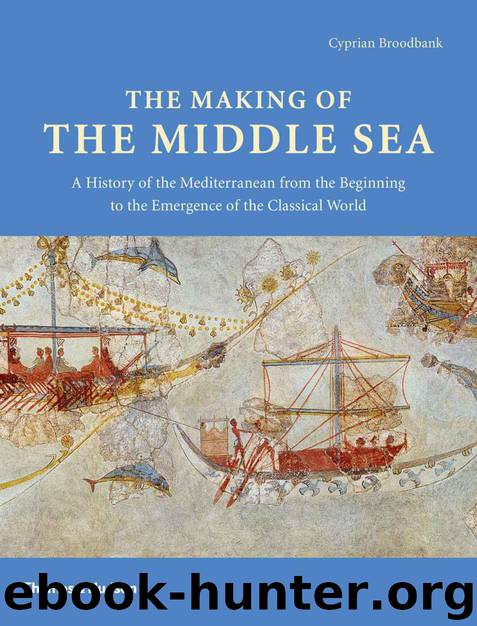The Making of the Middle Sea: A History of the Mediterranean from the Beginning to the Emergence of the Classical World by Broodbank Cyprian

Author:Broodbank, Cyprian [Broodbank, Cyprian]
Language: eng
Format: epub
Publisher: Thames and Hudson Ltd
Published: 2013-12-01T22:00:00+00:00
8.58 A boat-shaped house at Es Coll de Cala Morell on Menorca, mid-2nd millennium BC in date and still broadly similar to those occupied by the first generations of Balearic islanders.
8.59 The cliffs of Menorca are riddled with rock-cut tombs mainly dating to the 2nd millennium BC.
Further east, from Catalonia to Mediterranean France, among a patchwork of coastal lagoons, cleared lowlands, surviving woods and limestone uplands, the social and economic profile remained modest among the communities living by farming plus, in France, still a substantial amount of hunting.415 Near the mouth of the Rhône, as before a favoured point at the convergence of coastal and interior routes, a sizeable defended enclosure arose at Camp de Laure,416 but otherwise communities remained small and simple, indeed even less noticeable in the second half of the millennium than the first, with few striking finds save for a handful of pieces of faience and amber percolating in from the north. Copper mining actually declined in the Midi, as local mineralizations were eclipsed by larger, more organized extraction of the high Alpine ores, in the west notably at Saint-Véran.417 Throughout the 2nd millennium BC southern France kept its back to the sea and maintained an introverted way of life, largely sufficient unto itself in an unusually clement Mediterranean niche. Together with the open seas of the west, this created a substantial buffer between Argaric developments and others in the central Mediterranean.
An island of towers
Heading southeast from France over the apparently largely empty sea, we bear down on another archaeologically prominent zone that rivals the Argaric in its demand for our attention. Corsica was in this respect secondary to its larger neighbour, and more cut off. Corsican dolmens and especially menhirs retained great local significance; over 250 of the latter were aligned in attenuated rows at Palaghju [8.60], while at Filitosa a strange complex of towers, menhirs, huts and perimeter wall was erected from around 1600 BC.418 Meanwhile, in the south a few stone towers (torres) mirrored on a stubbier scale a new way of life across the Strait of Bonifacio. For in Sardinia an extraordinary new template for the standard living unit emerged, one that thrust 15–20 m (50–65 ft) skyward in a thick granite- or basalt-walled, multi-storey conical tower topped with a balcony, dark and pokey on the inside but out in the landscape prominent from afar [PL. XXXV].419 We have already come across these nuraghi (a name traceable to Roman times, and surely Bronze Age in origin) in Chapter 1 as identity symbols for modern separatists, and in this chapter as robust ruins that encourage population estimates.
Download
This site does not store any files on its server. We only index and link to content provided by other sites. Please contact the content providers to delete copyright contents if any and email us, we'll remove relevant links or contents immediately.
The Daily Stoic by Holiday Ryan & Hanselman Stephen(3110)
The Fate of Rome: Climate, Disease, and the End of an Empire (The Princeton History of the Ancient World) by Kyle Harper(2872)
People of the Earth: An Introduction to World Prehistory by Dr. Brian Fagan & Nadia Durrani(2619)
Ancient Worlds by Michael Scott(2493)
Babylon's Ark by Lawrence Anthony(2430)
Foreign Devils on the Silk Road: The Search for the Lost Treasures of Central Asia by Peter Hopkirk(2388)
The Daily Stoic by Ryan Holiday & Stephen Hanselman(2344)
India's Ancient Past by R.S. Sharma(2295)
MOSES THE EGYPTIAN by Jan Assmann(2275)
The Complete Dead Sea Scrolls in English (7th Edition) (Penguin Classics) by Geza Vermes(2135)
Lost Technologies of Ancient Egypt by Christopher Dunn(2111)
The Earth Chronicles Handbook by Zecharia Sitchin(2101)
24 Hours in Ancient Rome by Philip Matyszak(1973)
Alexander the Great by Philip Freeman(1960)
Aztec by Gary Jennings(1878)
The Nine Waves of Creation by Carl Johan Calleman(1783)
Curse Tablets and Binding Spells from the Ancient World by Gager John G.;(1768)
Before Atlantis by Frank Joseph(1740)
Earthmare: The Lost Book of Wars by Cergat(1715)
